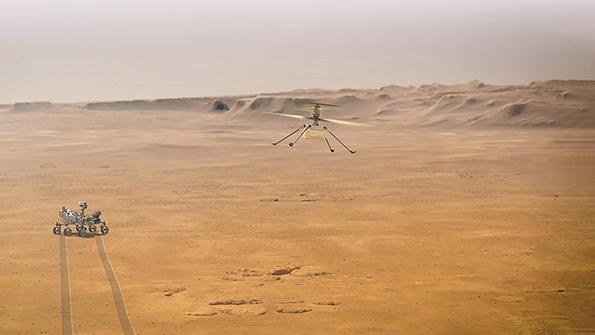
Imagine it is 2025. After five years, air travel has recovered to beyond pre-COVID-19 levels, resuming its historical growth trajectory. Airbus is finalizing the key technical decisions for a mid-2030s’ zero-emissions airliner, and Boeing is developing its first new commercial aircraft since the 737 MAX returned to service.
The first small hybrid-electric and hydrogen fuel-cell aircraft are reducing emissions on short routes in environmentally sensitive regions. Electric air taxis are shuttling passengers between airports and business centers, and the first regional air-mobility networks are taking shape.
Remotely piloted cargo aircraft are connecting regional warehouses and distribution centers, keeping the e-commerce juggernaut humming. Medical drones are speeding between hospitals and laboratories, pharmacies and communities as the year’s coronavirus vaccines are deployed.
The first air-, land- and sea-launched hypersonic missiles are operational with the U.S. military, giving it a flexible and tactical response to Chinese and Russian threats. The first elements of multi-domain command and control are in place, artificial-intelligence (AI) algorithms helping pair weapons with targets across platforms and services.
A new generation of high-speed rotorcraft has entered full-scale development for military and commercial missions. Optionally piloted capability is beginning to extract increased utility from existing vertical-lift platforms. And electric vertical-takeoff-and-landing technology is making inroads into traditional light helicopter markets.
Since 2021, a fleet of commercial spacecraft has been delivering payloads to the lunar surface and into orbit around the Moon, paving the way for a sustained human presence. The first commercial payloads are on their way to Mars. And the search for life beyond Earth has widened, with NASA’s Europa Clipper space probe on its six-year journey to survey the water-covered moon of Jupiter.
These projections have their basis in seeds sown in 2020, a year most would rather forget—a year of pandemic shockwaves and political divisions that will reverberate well into 2021. But the new year opens with a massive logistics effort underway to deploy coronavirus vaccines. A recovery in air travel is expected once broader immunization is achieved in the second half of 2021.
On the defense side, the costs of combating COVID-19 could constrain spending, but technology trends are established. The U.S. is embarking on a campaign of flight tests leading to fielding its first boost-glide hypersonic missiles in 2023, with air-breathing weapons to follow. Experiments with manned-unmanned teaming and AI--augmented networking are laying the foundations for a more connected battlespace.
NASA still plans to return humans to the Moon in 2024 but will require sustained technical progress and political support to stay on track. A successful landing of the Mars 2020 rover mission in February 2021 will help maintain its exploration momentum. SpaceX’s Elon Musk remains bullish on launching an uncrewed mission to Mars in 2024—assuming a successful Starship orbital flight in 2021.
Perhaps surprises of 2020 were the focus on sustainability and the progress made by electrified propulsion. Manufacturers and operators united to call for greater government support to scale up sustainable aviation fuels, grand plans for hydrogen in aviation made the headlines, and hybrid-electric and fuel-cell demonstrators scored flight-test firsts.
It was a year of dramatic reversals, but 2020 was also a year of progress that kept a more positive vision of the future within reach.
KEY INTEL
Defense
Global Defense Outlook | Competitions To Watch
Defense Profiles
Global military aircraft competitions and country-by-country analyses of national budgets and programs:
U.S. | Canada | China | Russia | UK | France | Germany | Eastern Europe | Middle East | Israel | India | Japan | South Korea | Brazil | Australia
Military Aircraft
Anticipating pivotal fighter choices, stealth-bomber rollouts and an expanded role for airlifters
Defense Systems
Experimentation advances the networked battlefield, hypersonic missiles and loyal wingmen:
Networked battlefield | Missiles | Unmanned systems
Rotorcraft
Modernization of military fleets is an increasing priority, while commercial industry hopes for a bounce-back:
Spaceflight
A pivotal year for commercial human spaceflight, the oncoming wave of LEO constellations, developments in the smallsat market and technologies to watch:
Commercial Aircraft
Narrowbodies sustain industry while the widebody market stays weak and OEMs look to future airliners
Commercial Aviation Outlook and supply chain
Air Transport Profiles
As air travel returns, recovery profiles differ for legacy airlines, low-cost carriers, long-haul LCCs and cargo carriers:
Legacy airlines | Low-cost carriers | Long-haul LCCs | Cargo carriers
Safety
Boeing’s 737 MAX returns to service having reshaped the certification process:
737 MAX Return Starts New, Complex Phase
Sustainability
Reducing climate impact reasserts itself as a driving concern for aviation:
Airlines Look To Green Comeback
Business Aviation
The pandemic-induced embrace of private flying could boost business aviation in the next decade:
Maintenance, Repair & Overhaul
Airlines retiring less efficient aircraft as the market recovers could reshape the maintenance, repair and overhaul industry:
Worldwide 2021 Outlook for MRO By Region | Aftermarket Rally Will Vary By Segment | MRO Looks To 2021 To Begin Slow Recovery | What's In And What's Out For 2021 In MRO | MRO Trends To Look For In 2021 | Top 10 Pandemic-Driven Aircraft And Cabin Innovations
Data Centers
Five-year delivery forecasts and specification tables for:
Combat and transport aircraft | Commercial and business aircraft
People to Watch
Defense | Space | Airline and Aerospace | MRO
